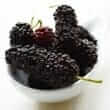Background
- Mulberry is native to China and became naturalized and hybridized in Europe and America centuries ago. Indian mulberry (Morinda tinctoria) is reportedly used by the African aborigines medicinally, but there is no reliable evidence of its therapeutic value. In India, the root-bark of Morus alba, known locally as san-pai-p'i, is used as a diuretic (increasing urine flow) and expectorant (an agent that increases bronchial secretions and facilitates their expulsion through coughing, spitting or sneezing).
- Herbalists have used mulberry fruit for oral infections. The bark of Morus nigra is also a reputed anthelmintic (medication) for tape worms.
- At present, black mulberry (Morus nigra) is most commonly used for its antioxidant properties. It is also popularly used in the preparation of flavored syrup used in medicine and as a laxative in the treatment of constipation. Black mulberry has been indicated for a variety of other conditions, though all indications lack sufficient scientific data supporting their safety and efficacy at this time. Further research in these areas is warranted before firm conclusions can be drawn.
References
Natural Standard developed the above evidence-based information based on a thorough systematic review of the available scientific articles. For comprehensive information about alternative and complementary therapies on the professional level, go to . Selected references are listed below.
- Caiaffa MF, Cataldo VM, Tursi A, et al. Fig and mulberry cross-allergy. Ann.Allergy Asthma Immunol. 2003;91(5):493-495.
View Abstract - de Souza MM, Bittar M, Cechinel-Filho V, et al. Antinociceptive properties of morusin, a prenylflavonoid isolated from Morus nigra root bark. Z Naturforsch.[C.] 2000;55(3-4):256-260.
View Abstract - Fu DX, Chen L, Hou AJ, et al. Constituents of Morus nigra. Chinese Traditional and Herbal Drugs 2005;36.
- Kim H, Yoon YJ, Shon JH, et al. Inhibitory effects of fruit juices on CYP3A activity. Drug Metab Dispos. 2006;34(4):521-523.
View Abstract - Muntean D, Imre S, Avrigeanu V, et al. Physico-chemical study of the isolated flavonoids from leaves and bark of Morus alba L. and Morus nigra L. species. Farmacia 2002;50:97-103.
- Naderi GA, Asgary S, Sarraf-Zadegan N, et al. Antioxidant activity of three extracts of Morus nigra. Phytother.Res. 2004;18(5):365-369.
View Abstract - Rabijns A, Barre A, Van Damme EJ, Peumanset al. Structural analysis of the jacalin-related lectin MornigaM from the black mulberry (Morus nigra) in complex with mannose. FEBS J 2005;272(14):3725-3732.
View Abstract - Rouge P, Peumans WJ, Barre A, et al. A structural basis for the difference in specificity between the two jacalin-related lectins from mulberry (Morus nigra) bark. Biochem Biophys.Res Commun. 4-25-2003;304(1):91-97.
View Abstract - Singh T, Wu JH, Peumans WJ, et al. Recognition profile of Morus nigra agglutinin (Morniga G) expressed by monomeric ligands, simple clusters and mammalian polyvalent glycotopes. Mol Immunol. 3-30-2006.
View Abstract - Wu AM, Wu JH, Singh T, et al. A novel lectin (Morniga M) from mulberry (Morus nigra) bark recognizes oligomannosyl residues in N-glycans. J Biomed.Sci 2004;11(6):874-885.
View Abstract







